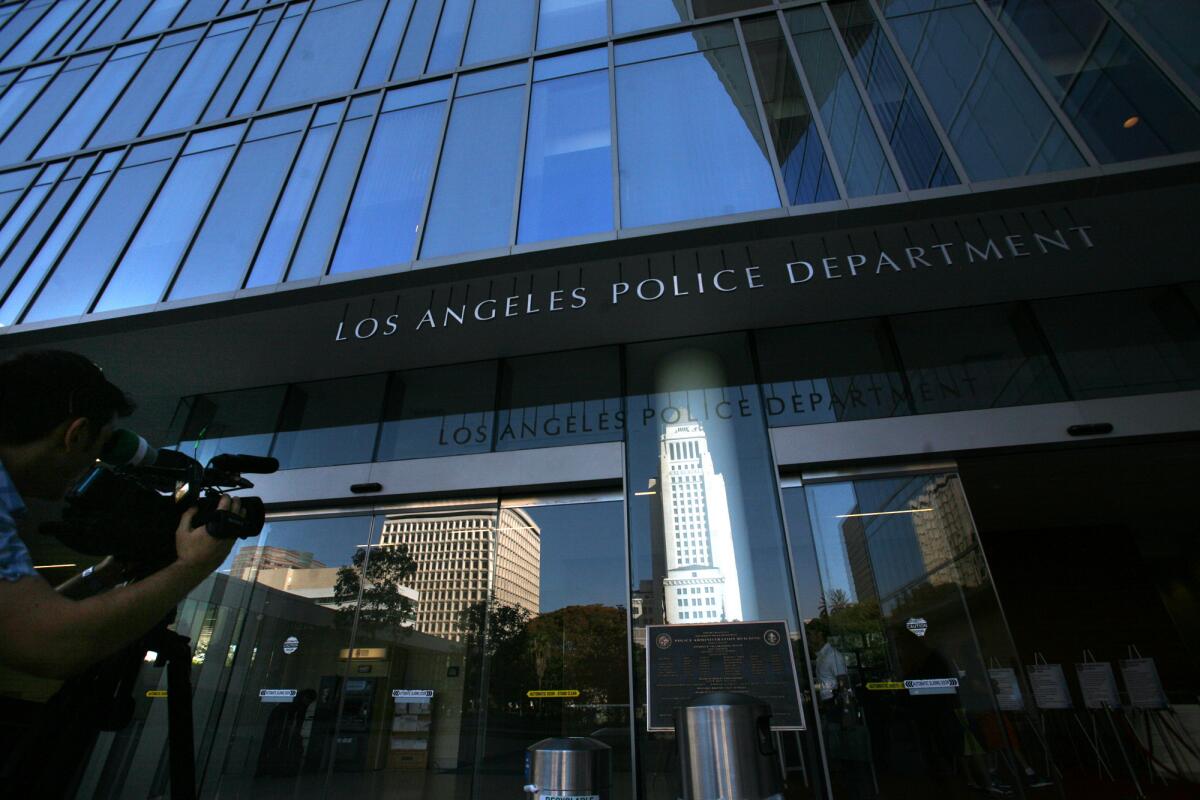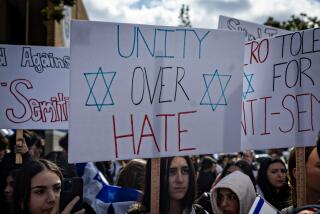L.A.’s surge in homicides fueled by gang violence, killings of homeless people

- Share via
Curtis DeTurk had always been a “drifter,” but he had a dream, according to his sister Shelby Schnitz.
A religious man from a tightknit family, DeTurk, 27, had recently moved from Indiana to Los Angeles with the hope of becoming a famous guitar player. “He just wanted a fresh start where no one knew him and he could become famous,” she said.
Instead, DeTurk was shot dead earlier this month while asking for change outside a North Hollywood pizzeria — a tragic fate similar to those of dozens of other people experiencing homelessness in L.A. this year.
“It’s beautiful and not so beautiful at the same time,” Schnitz said of L.A.
In a year defined by challenges, L.A. is approaching a benchmark of violence not seen in a decade: 300 homicides in a single year. It hasn’t happened since 2009. There had been 274 killings in the city as of Wednesday.
The causes are complex and varied — and some sadly familiar.
Out of nearly 80 homicides in Central Los Angeles through the end of last month, more than half were suspected of being gang-related, and more than 30 involved victims who were experiencing homelessness, according to the Los Angeles Police Department.
In the department’s South Bureau, more than a quarter of the 81 killings were suspected of being gang-related — with the motives in many others still unclear — and several involved homeless people.
Killings across the city have also been driven by drug disputes, domestic violence and robberies. Some seem inexplicable.
The figures — broken down in a homicide analysis sent to the Police Commission last week — reflect the latest police intelligence on a surge of violence that has catapulted L.A. past its total number of killings in each of the past two years.
The data reflect a broader uptick in homicides nationally, which President Trump has made an election talking point. They also reflect entrenched problems in L.A. that officials believe have been exacerbated by the realities of 2020 — particularly a cratered economy and social stresses related to the COVID-19 pandemic.
Longtime gang intervention worker Skipp Townsend said another likely factor is a spike in gun ownership that some on the street have told him was bankrolled in part by stimulus checks sent by the federal government to help shore up people’s finances amid massive job losses.
“Now they have the means and opportunity to go and hurt each other,” Townsend said of newly armed young men with petty beefs and unsettled scores.
For families who have lost loved ones this year in L.A., the violence is devastating and senseless.
Akeem “AJ” Coburn, 30, was fatally shot while standing in a driveway July 29 in the Harbor Gateway neighborhood. A father of two young girls, Coburn worked as a lineman for the Los Angeles Department of Water and Power, according to his family. Police are still trying to determine a motive and are offering a $50,000 reward for information.
Joel Bishop, Coburn’s cousin, said the family worries that so much time has passed without an arrest and that the pandemic is slowing down the investigation. Coburn deserved better, Bishop said, adding, “He was just in the wrong place at the wrong time.”
According to the LAPD’s analysis, the overwhelming number of killings this year have occurred outdoors, with certain neighborhoods in South and Central L.A. bearing the brunt of the violence.
In response, police are rushing to provide anti-violence programs and have enlisted principals, clergy members, gang intervention workers and other volunteers to assist. Communities across the city are running neighborhood watch programs.
Still, the increased gun violence has persisted, with police struggling to keep up. Of the city’s 274 killings, fewer than half have been solved, according to LAPD data.
From the beginning of August through the first week of October, the department’s South Bureau saw a 50% increase in homicides and a 146% increase in shootings, compared with the same period last year. In Southeast L.A., there were 40 shootings during that time frame, compared with 12 last year — a 233% increase. In the 77th Street area, there were 61 shootings, compared with 23 last year.
Shootings also were up substantially in the Central Bureau and the West and Valley bureaus, though the volume of incidents in the latter two was smaller.
Homicides also are up this year in the areas around the city that are covered by the Los Angeles County Sheriff’s Department, including East L.A. and parts of South L.A., Sheriff Alex Villanueva said Wednesday.
Capt. Joe Mendoza, a sheriff’s spokesman, said there had been 158 homicides as of Monday, a more than 22% increase over the same period last year and already more than the 141 homicides seen in all of 2019. The sheriff’s department also is investigating another 27 homicides for smaller cities in the L.A. area that don’t have their own homicide detectives — a nearly 50% increase in such cases compared to the same period last year, Mendoza said.
“Obviously there’s a surge in murders all across the county,” Mendoza said.
While the LAPD’s identification of individual gang members has not always been reliable, the involvement of gangs in street violence is not in question. Gang violence is a perennial driver of killings in the city, though police and community members have made great strides in reducing the impact from the 1980s and 1990s, when some years saw more than 1,000 people killed.
Beyond the gang violence in Central and South L.A., a dozen killings each in the Valley and West bureaus are suspected of being gang-related.
Police say gang gunfire has struck down suspected gang members but also innocent bystanders, including children and elderly residents.
Townsend said that while there has been an increase in gang shootings, the LAPD’s categorization of killings as gang-related can be overbroad — relying more on suspected gang affiliations among the people involved than on actual motivations in specific crimes.
What he has seen on the street of late, Townsend said, is arguments over women, fights over unpaid debts and domestic violence — people cooped up with new grievances and financial woes.
Homeless individuals are particularly susceptible to street violence, and L.A. has more than 35,000 people estimated to be living on the street. Last year, nearly 3,600 people experiencing homelessness were reported to be victims of violence or property crimes, while more than 5,700 were either arrested or suspected in such crimes, according to LAPD data.
In addition to the 31 homeless people who were killed in the Central Bureau area, 13 homeless people there were identified as homicide suspects, LAPD data show. In the South Bureau, one killing involved a homeless suspect, one involved two homeless victims and another involved a suspect and victim who both were homeless, according to the data.
During a virtual meeting of the Police Commission last week, LAPD Chief Michel Moore said the department is tracking the surge in violence and strategically deploying officers in an attempt to hold perpetrators accountable. Moore agreed that there is “a much higher presence of people carrying guns and bringing guns into disputes” this year and said increased gun thefts from vehicles are also a factor.
Officers in the department’s Metropolitan Division, a specialized citywide unit that focuses in part on crime suppression, have been redeployed to help investigate shootings, and Moore said that work will continue even as the department begins to reduce its force and implement other structural changes in coming weeks in response to a $150-million cut to its budget.
While the department has been criticized by activists and community advocates who say officers are heavy-handed and biased in communities of color, Moore said it is those same communities that have been “the most tremendously impacted” by the violence and are crying out for help.
Dany Carrillo-Ramos, 22, was killed in August after using an ATM in Watts. Carrillo-Ramos was walking to his car when a man walked up to him and tried to rob him. The two struggled, and Carrillo-Ramos was shot, police said. Anthony Dajuan Hodge, 26, was charged in August with murder, robbery and two gun charges, according to court records.
Carrillo-Ramos came to the United States when he was 17 in order to work and send money back to his mother, brother and daughter in Guatemala, said his cousin Yenifer Menchu. He never met his 5-year-old daughter, Menchu said, but was motivated to work by the prospect of paying for a good education for her back home. He wasn’t involved in drugs or gangs.
“He was a very responsible person,” Menchu said. “He never messed with anybody.”
“We still can’t accept the fact that we’re never going to see him again,” she added.
More to Read
Sign up for Essential California
The most important California stories and recommendations in your inbox every morning.
You may occasionally receive promotional content from the Los Angeles Times.












